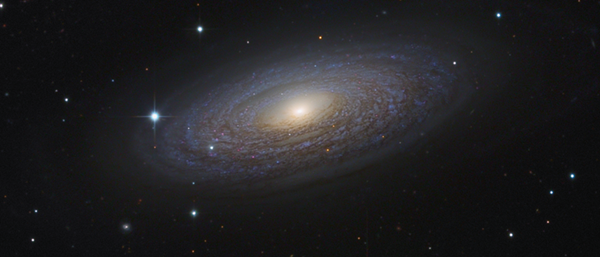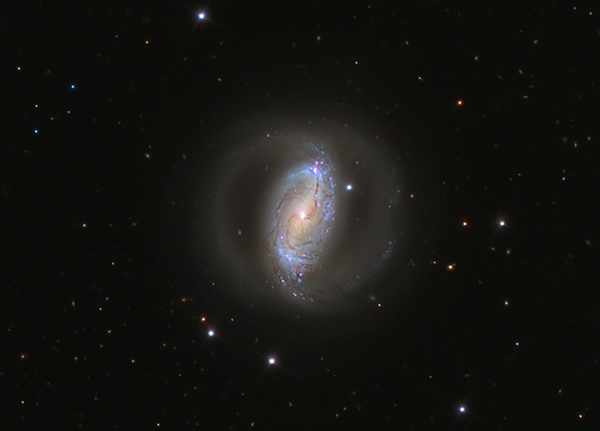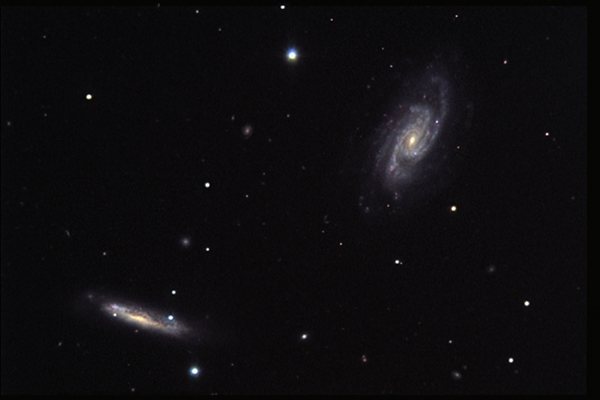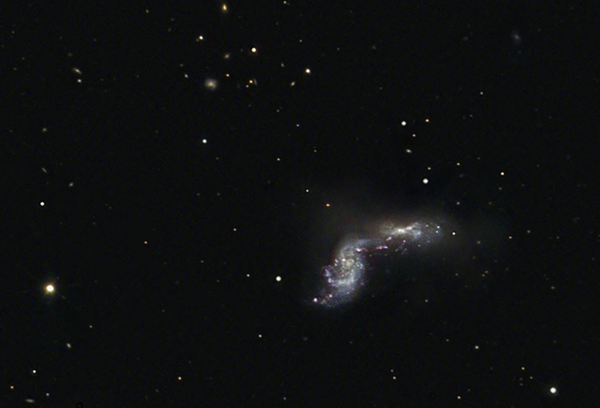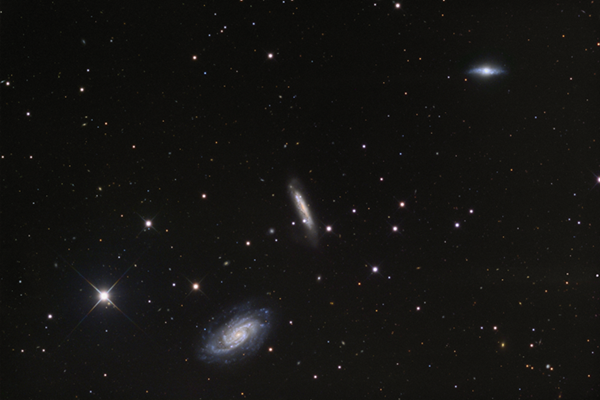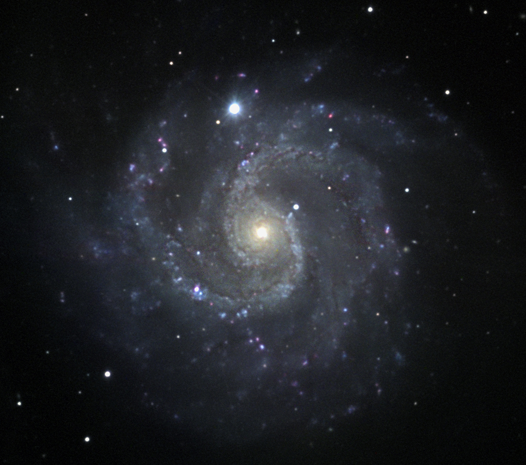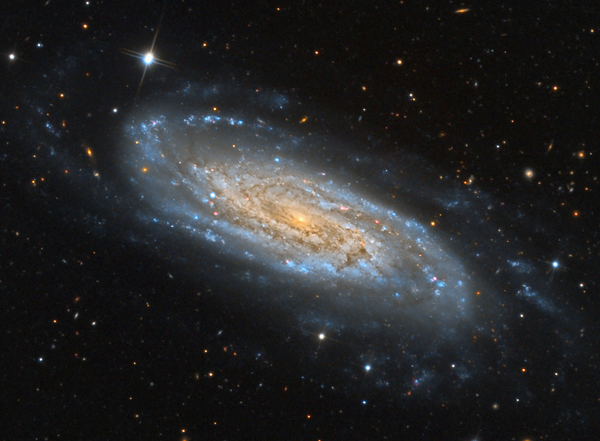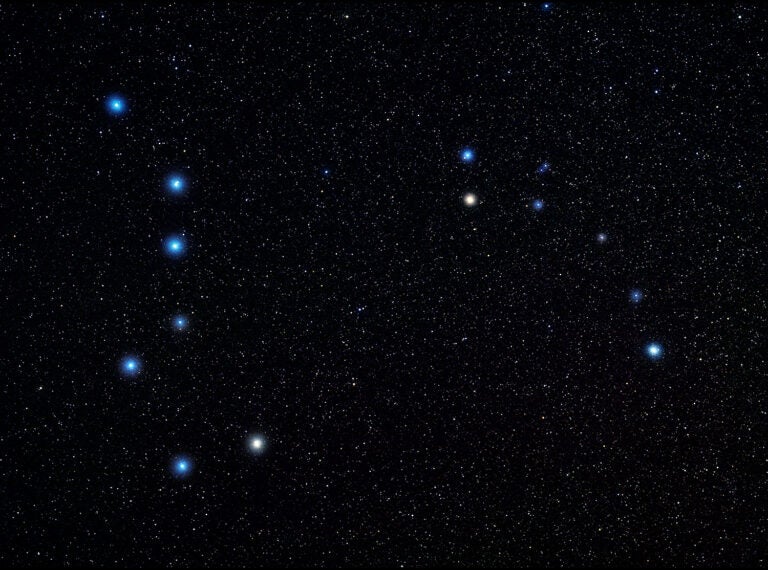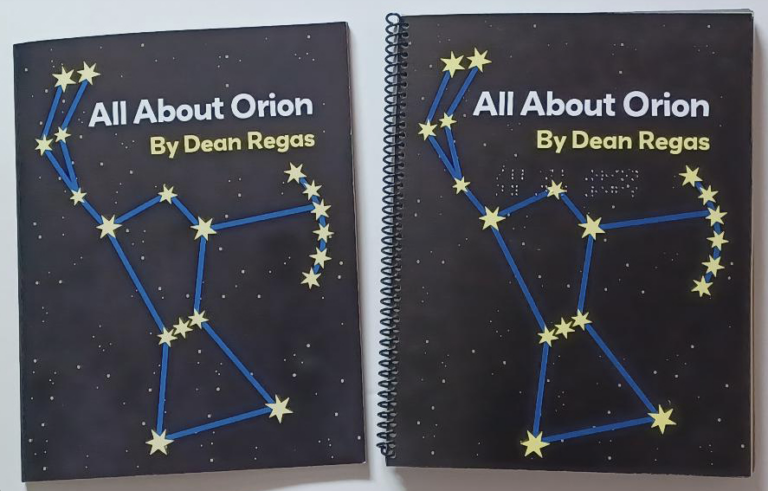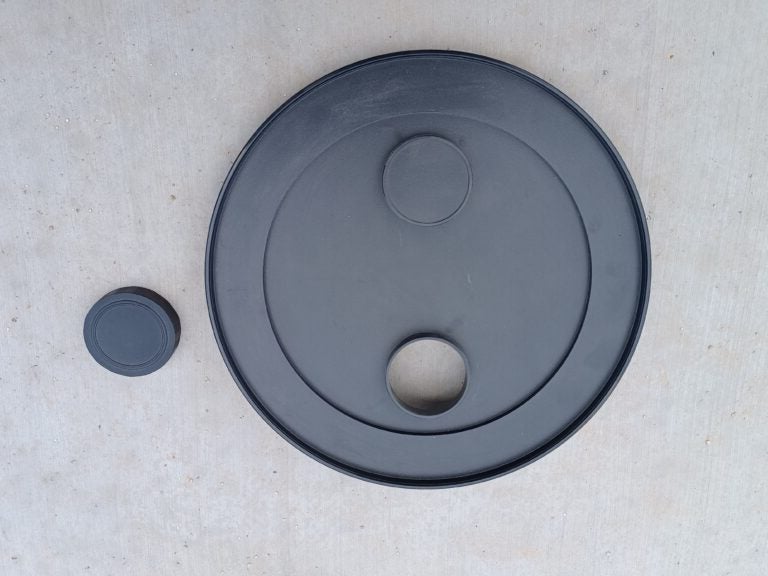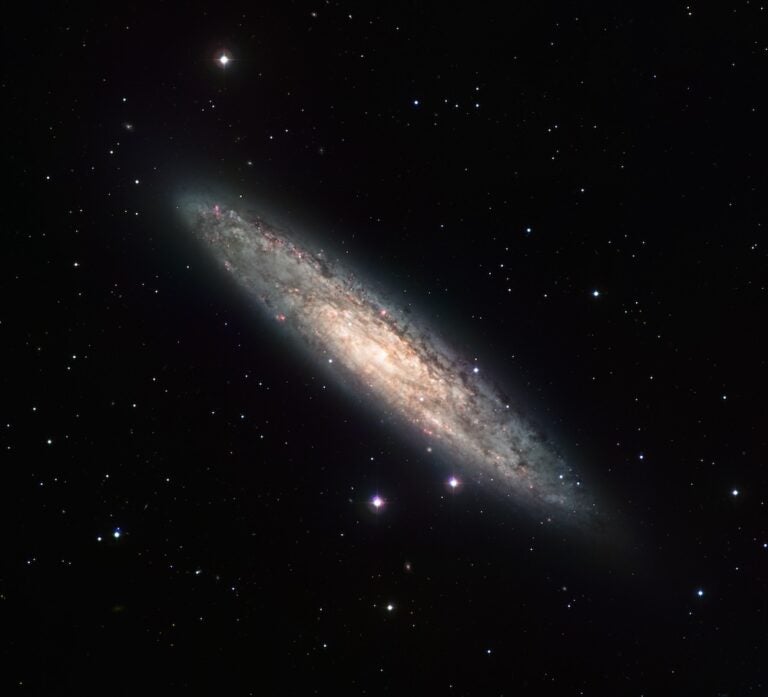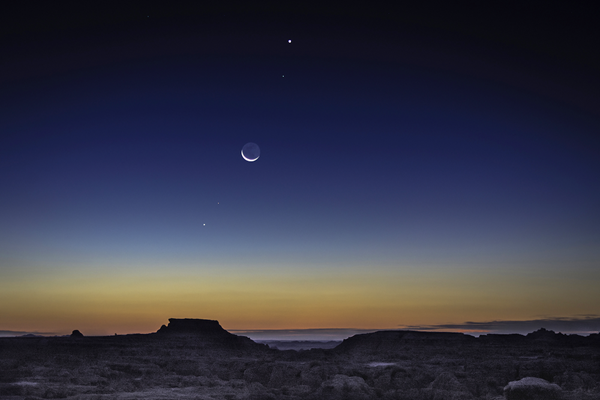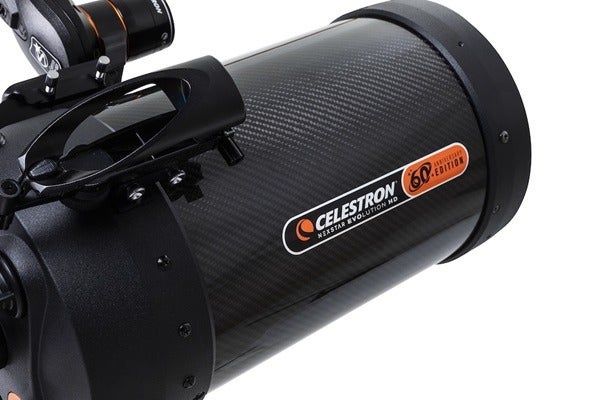Although the Gazelle has vanished from the sky, its stars have been reassembled into Leo Minor the Little Lion. Apparently, the Gazelle made the leaps to escape the swishing tuft of the greater Lion’s tail (Coma Berenices). And it is around or near these three leaps that we find a universe of mini-marvels and hefty extragalactic sights, some of which will challenge observers who have small telescopes. Since the pairs of stars in the leaps also tickle the borders of Lynx and Leo Minor, I’ve included galaxies from those constellations in the search as well.
The first leap
Begin at Xi UMa (Alula Australis; the southern toe of the Bear’s right hind foot) and then locate 6th-magnitude 44 Leonis Minoris about 7° to the southwest. Center that star in your telescope, because your first mini-marvel, NGC 3414 (Arp 162), lies just 20′ to its west. This 11th-magnitude extragalactic “spark” is an enigma among galaxies. In images, it looks like a disturbed lenticular system, with diffuse counter-tails and filaments, a rudimentary disk, and an S-shaped bar, but some astronomers suspect it may be a galaxy with a large polar ring seen edge-on. Whatever the type, this 3′-long concentrated spot of light (with a tiny stellar nucleus) is visible through a 4-inch at 72x, but don’t expect to see much more detail.
Drop about 1° south-southwest from NGC 3486 to 11th-magnitude NGC 3504. Here we have a smaller (2.5′ across) face-on barred spiral. Due to their low-surface-brightness arms, face-on spirals can be difficult to observe even when moderately large and bright. (Think of M74 in Pisces.) But NGC 3504’s smaller size creates a slight advantage because it condenses the view. Through a 4-inch at 72x, the galaxy displays an elliptical disk, oriented northwest to southeast, with a bright core and starlike nucleus. See if the dim surrounding glow (the collective light of the arms) doesn’t suddenly appear like the loping ears of a circumscribed halo. These lobes are actually tight swirls of spiral structure jutting from a bright-tipped bar and curling to form a ring.
The last Leo Minor galaxy in this tiny pride of four is the challenging NGC 3510 — the Phantom Flame. You’ll find it about 50′ east and slightly south of NGC 3504, just east of a 7th-magnitude star. Like NGC 3414, this edge-on spiral, with a warped outer plane and knotty inner barlike core, is an enigma because astronomers cannot find nearby companions upon which to blame the warping. As for the challenge, this 13th-magnitude needle 46 million light-years distant measures only 3′ long and 1′ wide, with a whisker-thin (0.85′ by 0.08′) bar of light at its core.
A few “tweener” galaxies
Let’s look now between the Bear’s toes — between Nu UMa (Alula Borealis; the northern toe of the right hind paw), and Mu UMa (Tania Australis; the southern toe of the left hind paw) — at 5th-magnitude 46 UMa, which, to confuse matters, neighbors 4th-magnitude 46 LMi.
Center NGC 3430 and nudge the telescope about 30′ west, where you’ll find two more members of the LGG 218 group: NGC 3395 and NGC 3396, a double galaxy with connecting arms (together known as Arp 270) in the early stages of a merger. You’ll need 100x and greater to separate the two 12th-magnitude components, which span about 1′ across; NGC 3395 is westernmost of the two glows. Deep-sky observers Steve and Amelia Goldberg of Houston share that they “seem to ‘conflict’ with one another” as to which galaxy, NGC 3395 or NGC 3396, appears larger. See what you think.
Return to NGC 3430 and slide your scope just 10′ southwest to another 12th-magnitude marvel: the amorphous irregular galaxy NGC 3413, which is not part of the NGC 3430 group. We see its 2′-by-2′ disk nearly edge on, making it mimic a lenticular galaxy in appearance, though it’s more akin to the Small Magellanic Cloud.
Marvels of the middle toes
The toes of the Bear’s left hind foot — Lambda UMa (Tania Borealis) and Mu UMa (Tania Australis) — are surrounded by three diverse galaxies. Our first target, 9.5-magnitude NGC 3184, lies only 45′ west of Mu UMa and just 10′ east-southeast of a 6th-magnitude star. Popularly known as the Little Pinwheel Galaxy, NGC 3184 is in shape and size a near dead-ringer for the galaxy I call the Great Pinwheel, M101, in the same constellation. Lying only 40 million light-years distant, this face-on spiral is visible in 10×50 binoculars under a dark sky. Telescopically, the galaxy’s 7.5′ disk has an 11th-magnitude field star on its northern flank; large-telescope users should take time to follow its long and swooping arms as they unwind in a grand spiral fashion from the rim of a small, smooth inner disk with a tiny pip of a nucleus.
Center Mu again, but this time make a slow and generous 3° sweep to the east, where you’ll find the isolated (and highly neglected) 11th-magnitude barred spiral galaxy NGC 3319. It’s a fun catch because while the galaxy’s bar (oriented northeast to southwest) is both sharp and bright, its open and patchy (HII-region rich) arms are hauntingly dim. So, small-telescope users may not see its full 6′-by-3.5′ disk. Those using large scopes should look for a knob of light at the bar’s southwest end. Try also to follow the arm swinging southward from the northeast end of the bar, as it makes a dramatic twist to the west where several HII knots enhance the view. NGC 3319 holds the distinction of being the last galaxy whose distance (47 million light-years) was determined from Cepheid variable stars as part of the Hubble Space Telescope Key Project.
Northern toe ring
We end our search by investigating a ring of galaxies around the toes of the Bear’s front right paw, marked by Iota UMa (Talitha) and Kappa UMa. Once again we start with a visual dynamo: NGC 2841, a small but bright spiral galaxy (47 million light-years distant) that lies only 11/3° west-southwest of 3rd-magnitude Theta (θ) UMa. Under a dark sky, a keen eye will spy it through 10×50 binoculars. Telescopically, the galaxy’s central lens and starlike nucleus are so bright, it can be seen during astronomical twilight. An elongated glow surrounds the lens, and the galaxy’s whirlpool of dappled dust combines to form a milky, smooth texture relaxing to the eye.
Almost 4° west of Theta shines 4.5-magnitude 15 UMa. Center that star, then move about 2½˚ farther west and a bit south to 11th-magnitude NGC 2681. This small but reasonably conspicuous — because it is so condensed (3.5′) — spiral appears as a finely etched circular glow with a circular core with bright nucleus. The galaxy gradually brightens inward, where large-telescope users may resolve its two brightest spiral arms, which form a near-perfect ring around the intense core.
The late American astronomer Halton Arp found 10 quasars near the 12.5-magnitude (3′ by 2′) elliptical galaxy NGC 2693 just 27′ south-southeast of NGC 2639, which has a 14th-magnitude (1′ by 1′) elliptical companion (NGC 2694) about 1′ to its south.
Our next mini-marvel lies just over 2˚ southwest of Kappa UMa. NGC 2712 is an oblique 12th-magnitude barred spiral (2.8′ by 1.5′) oriented nearly north to south, just over the border in Lynx. Its pale elliptical disk shows a central enhancement through a small telescope. But large scopes may reveal its weak bar and tightly wound (though well-developed) arms. Compare the brightness of the arms; do you see an asymmetry?
From NGC 2712, make a gentle 2° sweep due east to the neglected 11.4-magnitude open-face spiral NGC 2776, also in Lynx. While the object is a low-surface-brightness pale glow, it has a long needlelike nucleus immersed in a halo spanning 3′ by 2.5′.
We’ll end our toe ring survey by returning to NGC 2841, then dropping 1½˚ south to our final challenge object: NGC 2857 (Arp 1). This 13th-magnitude open-faced spiral galaxy (2′) is the first entry into 1966’s Arp’s Atlas of Peculiar Galaxies; Arp placed it in his class of “spiral galaxies with low surface brightness.” NGC 2857 shows two long, thin, tightly wound spiral arms that unwind like a pinwheel. It looks so small because this denizen lies 225 million light-years distant (more than 100 times the distance of M101 and only 25 percent smaller), so you can at least get an idea of what M101 would look like if it were 100 times farther away.
Don’t let the magnitudes of some of these objects prevent you from looking. You may surprise yourself with the challenging objects you can see and the amazing feelings you get from glimpsing galaxies that are so far away. Good luck.

